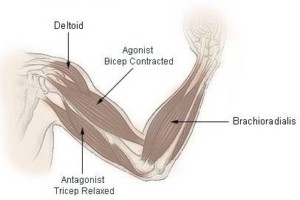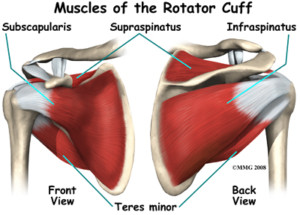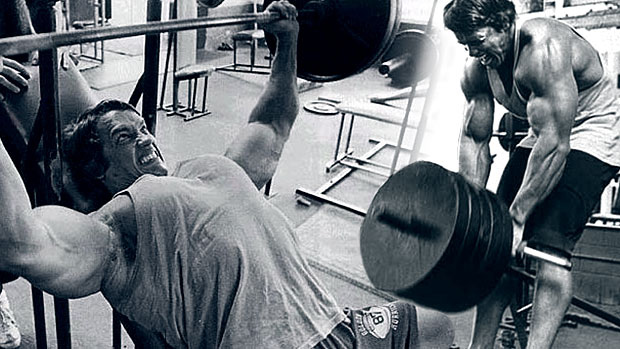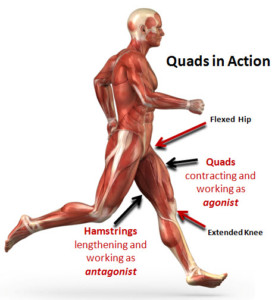Each of the major muscles involves in movement exists in a muscle relationship. In order to produce movement different muscles have different functions, which when done together produces the wanted movement. For example, muscles work in relationship to abduct the arm or to flex the knee.
For any movement there are various muscles that may function as: the prime mover or agonist, the antagonist, synergists, or stabilisers.
The Prime Mover is often called the agonist, but this is not technically the same thing. The prime mover is the main flexing muscle that causes the movement. While an agonist muscle is any muscle whose flexion produces movement. This means a synergist muscle is also an agonist muscle. The difference between a prime mover and a synergist muscle is that a prime (prime=main) mover is usually the largest muscle that is providing the most force to produce the movement, while the synergist muscles are often smaller and produce less force, while contributing to the movement, often refining the angle of movement so that the desired movement occurs.
For example, the pectoralis major is the prime mover and agonist muscle in horizontal adduction of the shoulder (as occurs during a bench press). However, there are smaller contributing, synergist, muscles that also contribute to the movement, such as the pectoral is minor and the anterior head of the deltoids. In a muscle relationship with the agonists are the antagonists. This muscles often exist in pairs, such as the biceps and triceps for flexion or extension of the elbow, but this is not always the case. Antagonist muscles are the muscles that must relax in order for the agonist muscle/s to produce a movement. If we think back to our horizontal adduction the latissimus dorsi, trees major, rhomboids, trapezius and posters deltoid head must all relax, otherwise horizontal adduction will not occur. In its more simple form the biceps will flex the elbow as the agonist (causing movement) and the triceps will relax as the antagonist to allow movement.
In a muscle relationship with the agonists are the antagonists. This muscles often exist in pairs, such as the biceps and triceps for flexion or extension of the elbow, but this is not always the case. Antagonist muscles are the muscles that must relax in order for the agonist muscle/s to produce a movement. If we think back to our horizontal adduction the latissimus dorsi, trees major, rhomboids, trapezius and posters deltoid head must all relax, otherwise horizontal adduction will not occur. In its more simple form the biceps will flex the elbow as the agonist (causing movement) and the triceps will relax as the antagonist to allow movement.
 Finally many joints also have stabilisers. This is especially the case for ball and socket joints such as the shoulder or hip. Stabiliser muscles work to stabilise the joint that is being moved in order to help prevent dislocation. For example, the rotator cuff muscle group (Subscapularis, Supraspinatus, Infraspinatus, and Teres minor) of the shoulder is a group of small muscles that help pull the head of the humorous into the joint capsule of the scapula. These muscles are used during the horizontal adduction in order to stabilise the joint and prevent the pectorals major from pulling the humorous out of its socket.
The main muscle relationship you need to know is the agonist-antagonist muscle relationship.
Finally many joints also have stabilisers. This is especially the case for ball and socket joints such as the shoulder or hip. Stabiliser muscles work to stabilise the joint that is being moved in order to help prevent dislocation. For example, the rotator cuff muscle group (Subscapularis, Supraspinatus, Infraspinatus, and Teres minor) of the shoulder is a group of small muscles that help pull the head of the humorous into the joint capsule of the scapula. These muscles are used during the horizontal adduction in order to stabilise the joint and prevent the pectorals major from pulling the humorous out of its socket.
The main muscle relationship you need to know is the agonist-antagonist muscle relationship.
 In a muscle relationship with the agonists are the antagonists. This muscles often exist in pairs, such as the biceps and triceps for flexion or extension of the elbow, but this is not always the case. Antagonist muscles are the muscles that must relax in order for the agonist muscle/s to produce a movement. If we think back to our horizontal adduction the latissimus dorsi, trees major, rhomboids, trapezius and posters deltoid head must all relax, otherwise horizontal adduction will not occur. In its more simple form the biceps will flex the elbow as the agonist (causing movement) and the triceps will relax as the antagonist to allow movement.
In a muscle relationship with the agonists are the antagonists. This muscles often exist in pairs, such as the biceps and triceps for flexion or extension of the elbow, but this is not always the case. Antagonist muscles are the muscles that must relax in order for the agonist muscle/s to produce a movement. If we think back to our horizontal adduction the latissimus dorsi, trees major, rhomboids, trapezius and posters deltoid head must all relax, otherwise horizontal adduction will not occur. In its more simple form the biceps will flex the elbow as the agonist (causing movement) and the triceps will relax as the antagonist to allow movement.
 Finally many joints also have stabilisers. This is especially the case for ball and socket joints such as the shoulder or hip. Stabiliser muscles work to stabilise the joint that is being moved in order to help prevent dislocation. For example, the rotator cuff muscle group (Subscapularis, Supraspinatus, Infraspinatus, and Teres minor) of the shoulder is a group of small muscles that help pull the head of the humorous into the joint capsule of the scapula. These muscles are used during the horizontal adduction in order to stabilise the joint and prevent the pectorals major from pulling the humorous out of its socket.
The main muscle relationship you need to know is the agonist-antagonist muscle relationship.
Finally many joints also have stabilisers. This is especially the case for ball and socket joints such as the shoulder or hip. Stabiliser muscles work to stabilise the joint that is being moved in order to help prevent dislocation. For example, the rotator cuff muscle group (Subscapularis, Supraspinatus, Infraspinatus, and Teres minor) of the shoulder is a group of small muscles that help pull the head of the humorous into the joint capsule of the scapula. These muscles are used during the horizontal adduction in order to stabilise the joint and prevent the pectorals major from pulling the humorous out of its socket.
The main muscle relationship you need to know is the agonist-antagonist muscle relationship. 

